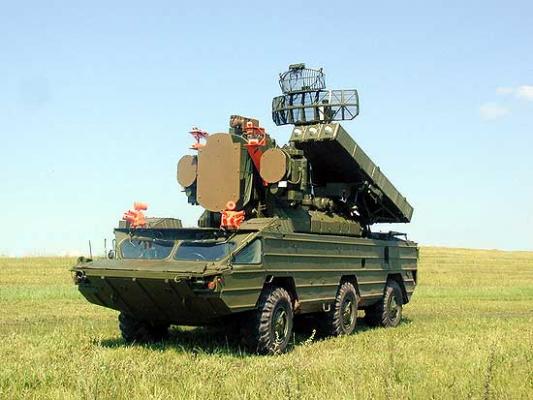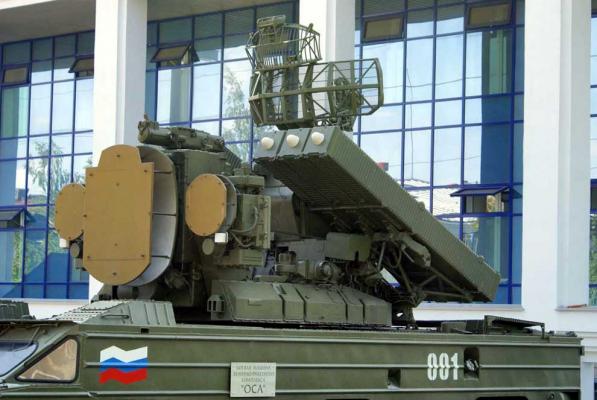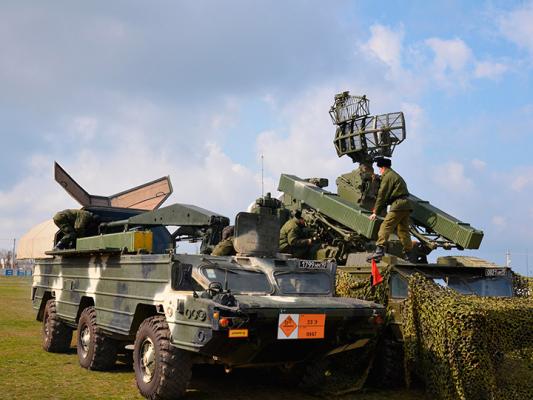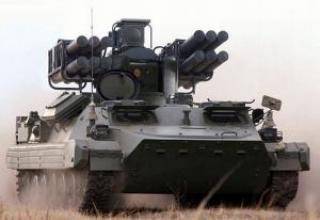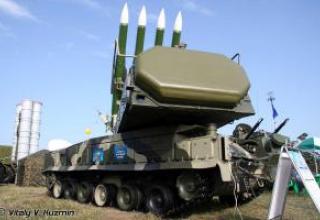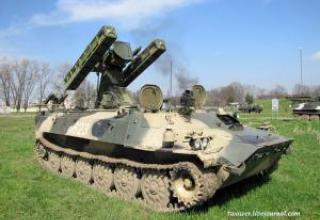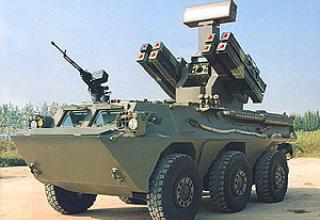The 9K33M3 Osa-AKM antiaircraft missile system is designed to protect troops on the march and in mobile types of combat, as well as strategic ground targets from manned and unmanned aerial attacks at low and medium altitudes.
The Osa-AK anti-aircraft missile system was unable to effectively fight fire support helicopters, the main modern means of fighting tanks. Elimination of this significant shortcoming was carried out during the implementation of the RCD "Mara", launched in November 1975 in accordance with the Decree of the CPSU Central Committee and the USSR CM.
In 1977, factory tests were carried out on the upgraded 9A33BM2 combat vehicle with the 9M33M2 ZUR, following the results of which the missile was modified in terms of a radio detonator and an electrical circuit to be named 9M33M3 ZUR. State tests of the modernized version of the complex, which received the designation 9K33M3 ("Osa-AKM"), were conducted at the Emba site from September to December 1979. (range manager V.V.Zubarev) under the guidance of the commission headed by A.P.Zubenko, and in 1980 the complex was adopted for service.
The complex is in service and successfully operated in the Navy, the military air defense of the Russian Armed Forces, the armed forces of CIS countries and the armies of more than 20 foreign countries, participated in hostilities and showed excellent results. Since 1989, the serial production of the Osa-AKM SAM system has been stopped.
Composition:
It is part of the complex:
- combat vehicle (BM) 9A33BM3 (see diagram, photo);
- 9T217BM2 transport and charging vehicle for 12 missiles;
- 9M33M3 antiaircraft guided missile (see figure);
- a 9B242-1 automated monitoring and test vehicle (see image);
- control equipment 9B914;
- maintenance machine 9B210M3;
- simulator 9F632M;
All combat vehicles of the complex were included in one combat vehicle of the Osa-AKM SAM system on a self-propelled wheelbase. The Osa-AKM SAM vehicle is autonomous and can independently detect, identify and fire air targets in any weather and combat situation. At the same time, the detection of air targets is carried out both on the march and on the ground, and the transition to escorting one of the targets and launching missiles are carried out from a short stop or from the ground. The most dangerous targets can be fired simultaneously by two missiles.
The combat vehicle consists of a 9P35M2 launcher, radar detection and target tracking stations (SOC), a ground-based radio interceptor system (GPR), two-channel missile sighting and command transfer radars (CWR), and a television optical vizier. To search for and identify a target on the move, the platform on which the SOC and NRZ antennas are located is stabilized relative to the horizon.
The floating chassis 5937 of high cross-country ability (wheel arrangement 6x6) is used as the base of the "Osa-AKM" complex. It is equipped with a high-speed diesel engine BD20K300 rated at 200.6 kW (300 hp). Transmission is made according to the onboard scheme. Wide profile tires have a pressure control device. Maximum speed on the highway up to 80 km / h. Movement afloat at a speed of up to 8 km / h are provided by two water-jet engines.
The system of navigation, top linking and orientation of the complex automatically detects the coordinates of the combat vehicle and carries out the laying of the course of its movement, as well as makes the mutual binding with other military means with the accuracy necessary to exchange information about the air situation. To maintain combat readiness and reliable assessment of the equipment of the Osa-AKM complex, an automatic system of built-in functional control is available. The equipment is powered on the move by a 9I120 gas turbine unit, and in the parking lot by a power take-off generator powered by a running engine. The crew is protected from means of mass destruction TZM 9T217BM2 is placed on a similar wheeled chassis.
The following measures have been implemented in the combat vehicle 9A33BM3:
- The effectiveness of group actions of SAMs has been improved through automation of the processes for target designation and distribution to battery combat vehicles, coordination of combat operations and more complete and sustainable information support of these processes. For this purpose, the BM is equipped with a built-in telescopic channel for battle control from the battery command post, which enables the optimal distribution of forces between combat vehicles and the rational use of ammunition;
- The LM has been modified for use in a mixed anti-aircraft missile-artillery battery. Data on target tracking coordinates are transmitted from the LM to an automated conjugation and pointing point to control the fire of anti-aircraft guns;
- The vehicle is equipped with a diversion device to protect the LM from anti-radar missiles, which significantly improves the effectiveness of the SAMs by creating false positions of the LMs and diversion to these devices PRR type "HARM";
- Replacement of the standard TV-optical sighting system by an electronic optical system with a thermal imaging channel, which provides round-the-clock operation of the redundant optical channel;
- the resolution of the circular view indicator of the target detection station in terms of range and azimuth has been improved by introducing an additional scale;
- the method of pointing the ZRG with a significant angular protrusion of the target sighting line by the missile in the vertical plane has been implemented by means of improvement of the counting and resolution device, which reduced the probability of the radio detonator triggering from the ground and reduced the influence on the accuracy of pointing the fluctuations of signals along the missile channel;
- to passively protect the LM from missiles with homing devices operating in the visible and infrared ranges by creating an aerosol wide-range shield by firing an aerosol munition;
- The introduction of an air conditioner in the LM, which significantly improves the crew's living conditions;
The 9MZMZ anti-aircraft guided missile is designed according to the aerodynamic scheme "duck" and consists of a glider, propulsion system, combat equipment, flight control equipment. The rocket is equipped with a solid fuel single-stage dual-mode rocket engine and is controlled by radio commands. The wings of the rocket are combined into a unit that rotates freely relative to the longitudinal axis. Aiming at the target radio command. The combat unit of the rocket - shrapnel and blast. An integral part of the SAM is a transport and launch container, in which the missile is for the duration of operation. The missile is delivered to the troops in its final form. In the course of operation, the missile is subject only to periodic technical condition checks by means of AKIPS 9B242-1.
The 9M33M3 missile differs from the 9M33M2 ZUR (Osa-AK complex) in that it has a modified radio detonator as well as a more powerful combat unit with an increased number of attack elements:
- the density of the fragments flow towards the target has been increased due to the forced issuing of a command to detonate the BC when the SLC approaching the target;
- a command was issued to the missile to correct the area of detonation of the radio fuse in accordance with the area of the BC splinters' flight when firing inhalation.
In comparison with the previous modifications, the Osa-AKM SAM system has the capability to engage helicopters at almost zero altitude (and flying at speeds up to 80 m/s) at ranges from 2 to 6.5 km with the exchange rate parameter up to 6 km. Hugh Cobra" helicopters on the ground are hit with a probability of 0.07-0.12, flying at an altitude of 10 m - 0.12-0.55, hovering at an altitude of 10 m - 0.12-0.38. When firing at helicopters at altitudes less than 25m in the complex uses a special method of pointing the SAM with semi-automatic target tracking on the angular coordinates with the help of TV-optical vizier.
BM ZUR is charged with TZM 9T217BM2, which also provides temporary storage and transportation of one to twelve missiles fixed in packets (six missiles on each side of the vehicle) and transportation of up to 550l of fuel reserve for BM. For loading and unloading operations the TZM is equipped with a rotary hydraulic crane.
BM 9A33BM3 can be modified for target complex "Saman-M". The target complex is designed to launch guided target missiles during training firing. In flight, a guided target missile can perform manoeuvres at various altitudes, thereby simulating the possible flight paths of modern airborne attack vehicles. A combat vehicle that has been modified to run an airborne target simulator can be used for its intended purpose. Improvement of 9M33M missiles in target missiles is carried out by removing the warhead, replacing the gunpowder charge of the engine, installing a calibrated radar reflector, replacing the head fairing, changing the electrical circuitry and composition of on-board equipment. Target missiles shall not be subject to combat use. A guided target missile can simulate different types of air targets and is used to prepare calculations and check the readiness of equipment for combat operations. The implementation of this direction allows to improve the combat training process and the training of BMD calculations. It is planned to equip the LM with control and recording equipment for recording parameters during the flights and firing tests in order to carry out operational control of the LM technical state and assessment of the combat firing results.
As a rule, as a rule, four combat vehicles, two TZMs and a battery command post (BCP) form an anti-aircraft missile battery, which can be used either independently or as part of an anti-aircraft missile division or regiment. The regiment (division) includes a command post (KP), up to five (three) batteries, technical battery (9B210MZ, and 9B914). Anti-aircraft missile regiments can be part of motorized rifle divisions or be regiments of army (corps) subordination, and antiaircraft missile divisions - part of motorized rifle (tank) brigades. Mobile control points of the PU-12M or PPRU-M1 type are used as BKPs to control battery combat operations by tablet method (by radio or telephone). The SM MP-25 radar data acquisition, processing and transmission machine and the KSM MP-22 or PU-12M combat control machine can be used as control means at the regiment's (division's) control point.
Characteristics:
| Mass of rocket 9M33M3,kg | 126.3 |
| Weight of combat unit, kg | 15 |
| The length of the rocket, mm | 3158 |
| Case diameter,mm | 206 |
| Wingspan,mm | 650 |
| ZUR flight speed, m/sec | 500 |
| Target detection range, km | up to 45 |
| Defeat zone, m - at a distance - in height - when it comes to rate |
1500...10000 25...5000 ±6000 |
| Defeated targets: - maximum speed, m/sec - target maneuver, food |
500 up to 8 |
| Probability of hitting a single ZUR fighter. | 0,5..0,85 |
| Number of missile channels | 2 |
| Accompanied by a TV-optical vision in the conditions of meteorological visibility and in the absence of smoke and dust, km | up to 25 |
| Response time, s | 16...26 |
| Time of transition of the complex from camping to combat, mines | up to 4 |
| The number of SSDs on a combat vehicle | 6 |
| Speed of movement of the complex (combat and transport-charging vehicles), km/h. - highway - afloat |
up to 60 up to 8 |
| Travel reserve on unpaved roads without refueling (with two hours of equipment operation from the gas turbine unit), km | 250 |
| The military calculation, man. | 4 |
Testing:
For the first time, the compound was used in combat operations in Lebanon to repel Israeli air strikes against Syrian forces, with several planes being shot down. A wide variety of techniques have been used to reduce the fighting ability of the "Osoya". In addition to electronic suppression, unmanned aerial vehicles were launched at SAM positions, simulating the actions of combat aircraft. After the SAM stockpile was exhausted, the positions of the complexes were attacked by Israeli aircraft. Thus, in one of the battles, three Syrian Osa SAMs were destroyed as a result of that attack, but a fourth was able to destroy an Israeli RR-4E.
"The Wasp was repeatedly used in combat operations in Angola against the South African Air Force. Thus, between 1987 and 1988, two UAVs and one aircraft were shot down by an Osa SAM system unit. SAMs were used by Libya to repel air strikes by American aircraft in April 1986.
When preparing for Operation Desert Storm, U.S. military experts considered the complex as one of the most effective means of air defense in Iraq. That's why on the eve of the operation itself Multinational Task Force units captured Wasp SAM systems on the territory of Kuwait together with the calculation and technical documentation in order to study and organize effective fight against it. These SAMs became one of the priority targets for suppression by various means during the initial hostilities. However, even in such a challenging environment, the Osa SAM has proven to be one of the most effective air defence capabilities, especially against Tomahawk cruise missiles, in a massive fire and electronic countermeasure.
Sources:
- Зенитные ракетные комплексы ПВО СВ. Техника и вооружения №5-6.99
- Р.Д. Ангельский "Отечественные ЗРК" Иллюстированный справочник- М.: ООО "Издательство Астрель", 2002.
- А.Соколов "Очень опасная Оса" "Танкомастер". 6/2003
- Зенитно-ракетный комплекс "Оса-АКМ" ОАО "ИЭМЗ "Купол"
- Russian Surface to Air Missiles
- “Осы” жалят без жалости
- Боевая машина 9А33М3 ЗРК "Оса-АКМ"Дмитрий Деревянкин
